
Digital vigilantism and the Boston Marathon bombing
The Boston Marathon bombing was a major event in the US and abroad. The tragedy has influenced many lives and led to one of the biggest online manhunts in history. Only hours after the event, the topic started attracting internet users to online communities trying to investigate the incident. The case sparked massive outrage on social media, with thousands of enthusiasts trying to help the investigation.
This case of digital vigilantism was brought about by anger and outrage. Digital vigilantism “can lead to several negative consequences” (Kosseff, 2016), and in the case of the Boston Marathon bombing it caused many false accusations and damaged reputations. Vigilantism in itself is not a new phenomenon - think of frontier justice practices such as gunfighting and lynching. Online vigilantism, however, is quite new, and it is here to stay. As a result, an important discussion on digital vigilantism and its harms is occurring online and offline. Although the Boston Marathon bombing has shown how social media users can collaborate as a group, it has also proved that willingness to pursue justice online can turn into a manhunt.
Boston Marathon bombing
The Boston Marathon bombing took place on the 15th of April, 2013. Two homemade bombs, made out of pressure cookers, went off in the middle of the crowd. As a result, three people were killed, and hundreds were injured. The event was broadly covered in both the American and international media.
The incident may someday be remembered as the first breaking news event that truly belonged to social media (Shea, 2013). The Boston Marathon bombing was captured by “‘accidental photojournalists’ – be they survivors, bystanders, first-responders, officials, law enforcement, combatants, activists or the like – [who felt] compelled to bear witness, often at considerable personal risk” (Allan, 2016). Moments after the bombing, the incident was recorded and shared by social media users all around the world. The accessibility of digital devices and the fast mobilization and spread of information across different online platforms (Allan, 2016) provided a great deal of footage and information to digital vigilantes.
Citizen journalism has shown changes in the "emerging new media ecology” (Andén-Papadopoulos, 2013) with “citizen eyewitness recordings [...] increasingly employed to help” (Andén-Papadopoulos, 2013) during civil crisis events. This type of journalism played an important role in the distribution of bombing-related content.
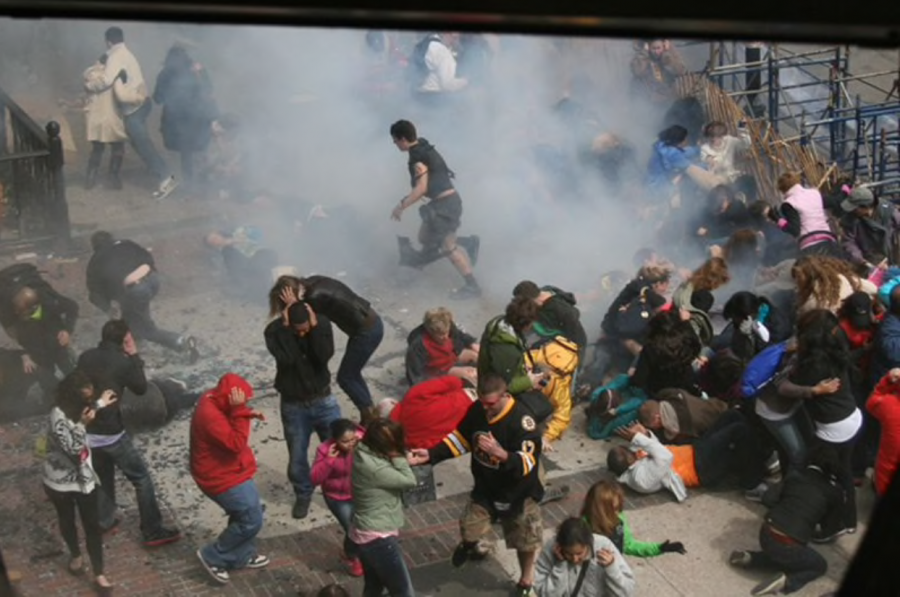
Figure 1: Picture taken from the office building above the marathon. The image captured the moments after the bombing as well as a possible fleeing suspect.
Witnesses of the event started uploading their "first-person documentation” (Allan, 2016) on multiple online platforms. The images of the bombings, victims, and the crowd were spread across the web. Such footage provided "frequently vivid, personalised insights (‘I was there and this is what happened in front of my lens’)” (Allan, 2016). Because of the personalized footage, or “‘amateur content’ to tell the story” (Allan, et al, 2015) of the event, many people on the internet felt sympathetic to the bombing's victims.
After watching “a form of documentation and expression that has a deep ‘reality-effect’” (Andén-Papadopoulos, 2013), internet users wanted justice. The tragedy was followed by one of the “largest, most sweeping investigations and manhunts in US history” (Nhan, et al, 2015). The effort to punish the perpetrators was not only initiated by police forces, but also by netizens. While officials made use of various investigative tools, analyzing explosives, blood patterns, surveillance videos, and infrared cameras (Nhan, et al, 2015), internet users tried to mobilize and contribute to the inquiry.
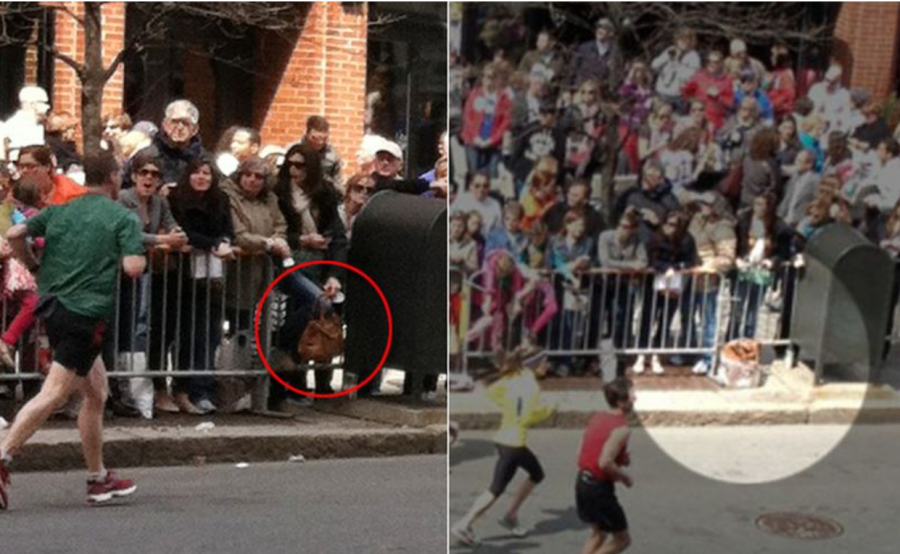
Figure 2: “Blast bag mystery deepens: Picture taken more than an hour before bombing shows woman holding purse (l.) that may be in bag in image (r.) taken just before the blast. Some observers believed that bag was a bomb parcel” (Ford, et al, 2013).
The situation provoked a wave of digital vigilantism – “a user-led violation of privacy that...transcends online/offline distinctions” (Trottier, 2016). Social media communities can actively serve as “‘additional eyes and ears’ of the police in an age where demands for efficient service with increasingly fewer resources are strained by new communications and analysis technologies” (Marx, 2013; Nhan, et al, 2015). Netizens feel a sense of responsibility inspired by some successful vigilantism cases. For example, in 2014 internet users helped Philadelphia Police find suspects “who brutally assaulted a gay couple by matching online Facebook profile pictures of people who checked in at the restaurant where the beating took place with surveillance video” (Nhan, et al, 2015). Unfortunately, not all digital vigilantism events are as successful. Digital vigilantism in the aftermath of the Boston Marathon bombing proved to be a very subjective and unreliable way to solve crimes.
The online community
In the case of the Boston Marathon bombing, “it was the first time online communities were actively involved in conducting their own investigation into a terrorist attack concurrently with the official police investigation” (Nhan, et al, 2015). The mobilization of internet users following the bombing showed how people with different backgrounds and expertise can unite online to solve complex issues.
The vigilante actions took part in a few steps. The Boston Marathon bombings provoked online teamwork and information crowdsourcing. Since users involved in digital vigilantism had different backgrounds, it helped to retrieve information from various sources and the search through multiple networks. Lots of footage distributed by citizen journalists helped users build the theories on who might be the culprit. This resulted in an outraged human flesh search online. The digital investigation took place on the social media platform Reddit.
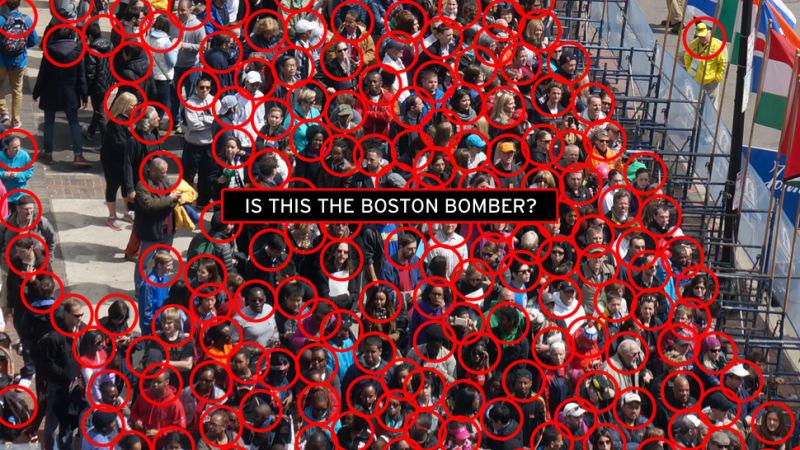
Figure 3: The crowd tried to identify the Boston bombers.
The cultural logic of Reddit played an important role in the case. The platform allows for the circulation of user-generated content and has a reach of over 330 million users (Pardes, 2018). Both of these factors allowed the platform to give rise to powerful social capital separate from “law enforcement’s symbolic capital, in the form of its centrality and leadership in the network, and political capital, derived from its ability to government resources, [which] are complementary to the public node’s cultural capital” (Nhan, et al, 2015). Social capital mobilized individuals from acround the world, forming their expertise into a collective knowledge. While normally different kinds of capital work together as parts of a whole system, digital vigilantism allowed for “parallel investigation” (Nhan, et al, 2015).
The affordances of Reddit allow the creation of user-generated subreddits on nearly any topic of interest. This structure causes a high level of involvement from users, who often participate in improving social issues, e.g. by donating to charity and philanthropic efforts (Morris, 2015). Since “digital vigilantism is a process where citizens are collectively offended by other citizen activity, and coordinate retaliation on mobile devices and social platforms” (Trottier, 2016), Reddit is a perfectly suitable platform for this purpose. Reddit gathers people with common interests and goals and allows for exchanging opinions. Because of the platform’s high involvement on specific topics, the subreddit r/FindBostonBombers was created the day after the Boston Marathon bombing.

Figure 4: Reddit interface in 2013. Users theorizing about the suspects.
The format of the platform's messaging contributes to drawing users' attention to the issue. News posts on Reddit are short and the “communication style of these messages is likely to be more interpersonal and subjective” (Welbers, et al, 2018); this played an important role in the case. The subreddit r/FindBostonBombers grew from r/news, and nobody expected it to become big (Reddit, 2014). However the event captured a lot of attention within the platform. Within the cultural logic of Reddit, including its reach, ability to create communities of interest, and the structuring of posts to capture attention, it took just hours to create a subreddit dedicated to the Boston Marathon bombing.
The rapid growth of the account
In just half a day, r/FindBostonBombers expanded to more than 3,000 users (Shea, 2013). As one of the moderators stated, the primary purpose of the subreddit was to encourage skepticism and critical thinking rather than “rampant vigilantism” (Reddit, 2014). The community was guided by a set of rules which were imposed harshly on the subreddit’s visitors. The purpose of such control was the realization that the subreddit r/FindBostonBombers could have had “potentially devastating effects with misinformation” (Reddit, 2014).

Figure 5: One of the moderators of r/FindBostonBombers sharing his experience one year after the event.
Some of the community’s rules forbid vigilante justice, posting of personal information, racism, and reposting of the images outside of the subreddit (Reddit, 2014). Fact-checking and theorizing were welcome. Generally, moderators encouraged users to remember that the subreddit is not a professional investigation medium: “Remember, we are only a subreddit. We must remember where helping ends and the job of professionals begins” (Reddit, 2014). The moderators also attempted to show that amateur investigations could impact the lives of real people: “Finally keep in mind that most or all of the “suspects” being discussed are, in all likelihood, innocent people and that they should be treated as innocent until they are proven guilty” (Reddit, 2014). Generally, moderators tried to keep the discussion calm, but it didn’t stop r/FindBostonBombers from quickly spiraling out of control.
At some point, the thread became so popular and widely discussed that it became impossible to effectively moderate. Soon after r/FrindBostonBombers' creation, “many Reddit users assumed the unofficial role of cyber-sleuth by acting as participants in the ongoing law enforcement investigation” (Nhan, et al, 2015). People started collecting pictures from the crime scene and trying to find the culprits.
Digital vigilantism can easily turn into a witch hunt. Some pieces of evidence were quite meaningful, while some resembled conspiracy theories from people who “clearly just watched too much CSI and thought that circling vaguely Arab-looking faces in bizarre diagrams made them super sleuths” (Shea, 2017). Such a state of affairs complicated the situation, putting pressure on people barely connected to the case.
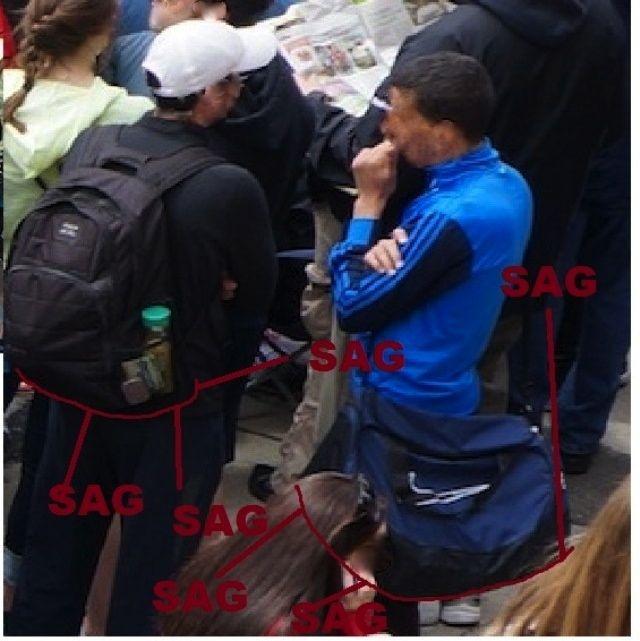
Figure 6: Redditors were analyzing people with ‘saggy’ dark bags as potential suspects.
The online witch hunt
When the attack occurred, police only had vague evidence: the remains of the pressure cooker(s) that served as a part of the explosion mechanism and a dark nylon backpack (Shea, 2017). When this information was published and picked up by social media, the goal of r/FindBostonBombers became finding people in the pictures of the crowd who had dark bags on their backs. This led to innocent individuals who had "saggy backpacks" being accused on their Facebook accounts as a result of the social media manhunt (Shea, 2017).
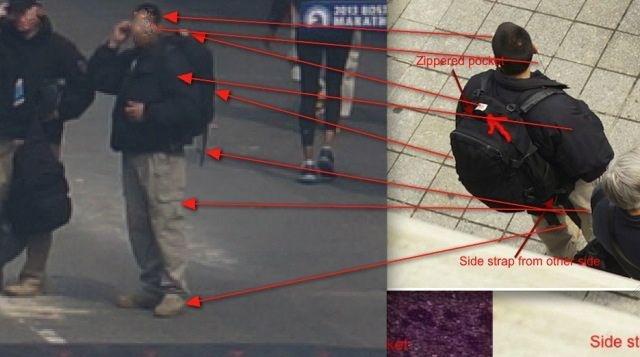
Figure 6: Redditors were analyzing people with ‘saggy’ dark bags as potential suspects.
One of the members of r/FindBostonBombers made a scheme of all the people who seemed suspicious to him. The Redditor chose 13 non-white men from the crowd, making it seem like a “Where's Waldo” game without actually knowing who Waldo was (Shea, 2017). The netizens called them: “Blue-robed Man, White Hat Black Jacket Guy, Blue Duffel Bag Guy [...], Green Hat Guy and a bunch of others” (Shea, 2017). Since nobody knew for sure who the person was (Shea, 2017), it created a collective urge to keep looking further. Despite the users' active involvement, the moderators of the subreddit tried to discourage any type of vigilante justice and stressed that all the found evidence would be redirected to the FBI (Shea, 2017).
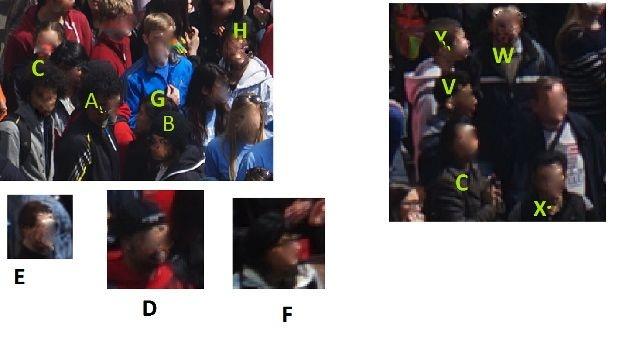
Figure 8: One of the redditors “put it down to 13 nonwhite men they identified in the crowds” (Shea, 2013).
The moderators and users treated r/FindBostonBombers as an assistance to police forces, like an online version of a police hotline (Shea, 2017). However, the actions of the subreddit community reminds one of crawling in the dark. Nobody knew how close they were to finding the actual perpetrators (Shea, 2017). Some people were publicly accused on r/FindBostonBombers, but there was not enough evidence to officially accuse anyone.
How r/FindBostonBombers went out of control
The pictures and theories on who might be the perpetrator were quickly picked up by numerous news outlets (Valdes, 2013). Despite users’ efforts, all of the suspects were wrongly identified (Valdes, 2013). One of the publicly accused individuals was Sunil Tripathi, a young Brown University student who was missing for a month before the bombing. The r/FindBostonBombers investigators connected this fact to him possibly preparing the attack and going undercover (Lee, 2015). Sunil became the main suspect in the case. News outlets quickly picked up this information and distributed it. However, it was a wrong assumption: the young man had committed suicide before the bombing and his body was later found in a local river.
Although the rules of the subreddit did not allow for accusation without solid evidence, many users picked up the theory about Tripathi. Some even started terrorizing his family on Facebook and leaving messages on Sunil’s page. Given the actual reason for the boy's disappearance, such media outrage was devastating for the family.
The vigilantism victim
Unfortunately, “the 2013 Boston bombing manhunt profoundly impacted the lives of those who were (wrongly) targeted, and received substantial media coverage” (Trottier, 2016). The subjectivity of news expression on social media (Welbers, et al, 2018) played an important role in the case. Usually, when “confronted with crisis situations, major news organizations tend to mobilize certain preferred, ritualized strategies and procedures to adjudicate the veracity of truth-claims that necessarily implicate them in a discursive politics of mediation” (Allan, et al, 2015). The subreddit r/news and other news outlets quickly picked up the message about the innocent Sunil Tripathi and spread it across multiple platforms. While the family of Sunil Tripathi was contacted by manhunters accusing the boy, the actual culprits were found by police.
To restore justice, public apologies were addressed to Tripathi’s family. Because “the visibility produced through digital vigilantism is unwanted [...], intense [...], and enduring” (Trottier, 2016), many Redditors encouraged donations to Sunil’s memorial fund, as well as to organizations focusing on mental health and the environment (Reddit, 2013).
The digital vigilantes were heavily criticized by both the mass media and their co-Redditors. Fellow Redditors left comments like: “Reddit still created conditions that could have led to a real life witchhunt and murder. The community needs to take responsibility for its actions” (Reddit, 2013) and that “A lot of redditors need to realize that dragging some ones names all throughout the mud is [...] horrible” (Reddit, 2013).
Discussion
The false accusations following the Boston Marathon bombings have sparked discussion on a few issues. New media allow netizens "to participate in critical civic discourse by collaboratively constructing and sharing previously inaccessible information across multiple platforms” (Cheong, et al, 2010). First of all, such accessibility sparks debate about how much the crowd can be involved in investigations and how much information police need to share with the people.
Second, the Boston Marathon bombing discussion on Reddit sparked an ethical practice issue. Who is authorized to draw the boundaries on what can or cannot be discussed about the victims and culprits of terrorist attacks or other tragic events? Digital vigilantism can easily cross boundaries. However, if we try to limit this freedom to discuss, do we, as a society, still provide freedom of speech? The issue opens up a discussion on the “nexus of new media and political communication [and] the role of the Internet in facilitating governmental transparency and participatory democracy” (Cheong, et al, 2010).
Lastly, we can discuss how accurate and effective digital vigilantism is. Digital vigilantism is a way to take action through the rise of the internet and social media. However, the Boston Marathon bombing case has shown that when led by anger and outrage, people tend not to base their reasoning on facts. “Vigilantes also may be driven by anger, bias, and other emotions that are not related to the public good” (Kosseff, 2016), which means that mistakes can be made when users accuse, doxx, or follow innocent people.
There are many negative aspects of digital vigilantism. However, the situation has shown one positive aspect of online activism. The speed of collective action and the high quality of cooperation show the advantages of digital vigilantism. People who were not connected in any way prior to the event managed to collectively organize and communicate clearly for a common goal. This level of initially uncoordinated action proves the mobility with which internet users can deal with crises.
Conclusion
Driven by anger and outrage, many internet users felt deeply involved and responsible for the investigation of the Boston marathon bombing in 2013. Using the “citizen-contributed imagery from global crisis event” (Andén-Papadopoulos, et al, 2013), Redditors gathered footage from the marathon and attempted to process this imagery to find the culprits.
Although led by good intentions, many mistakes and false accusations were made by Redditors. Invalid theories were quickly picked up by news outlets and spread around the world. An innocent person was accused and his family harassed. The media confusion stopped only after the official announcement from police.
The whole situation, however, has led to a mass discussion on the ethics and accuracy of digital vigilantism. Although done for a seemingly good cause, the online investigation did not contribute to finding the culprits and motivated hatred and blaming of innocent people.
There are many negative aspects to digital vigilantism. The Boston Marathon bombing case shows that internet activism can become a manhunt, with serious privacy violations of the parties involved. However, it also shows the high speed and mobility of users and the way they circulate information to contribute to the resolving of crises.
Digital vigilantism methods, in the case of the Boston Marathon bombing, have proved to be ineffective and incompetent. They lead to nothing but false accusations. Digital vigilantism can be called a rather harmful practice with no solid validation or evidence. Therefore, online vigilantism cannot be treated as a serious and legitimate method of criminal investigation.
References:
Allan, S. (2016). Citizen Witnesses. SAGE Publications.
Allan, S. & Peters, C. (2015). Visual truths of citizen reportage: four research problematics. Information, Communication & Society, 18(11), 1348-1361.
Andén-Papadopoulos, K. (2013). Media witnessing and the ‘crowd-sourced video revolution’. Stockholm University.
Andén-Papadopoulos, K., Pantti, M. (2013). Re-imagining crisis reporting: Professional ideology of journalists and citizen eyewitness images. SAGE.
Cheong, P. H. & Gong, J. (2010). Cyber vigilantism, transmedia collective intelligence, and civic participation. Routledge.
Ford, B., Smith, G. B., McShane, L. (2013). Police narrow in on two suspects in Boston Marathon bombings. DailyNews.
Kosseff, J. (2016). The hazards of cyber-vigilantism. Elsevier.
Lee, T. G. (2015). The Real Story of Sunil Tripathi, the Boston Bomber Who Wasn't. NBC News.
Marx, G. T. (2013). The Public as a Partner? Technology Can Make Us Auxiliaries as well as Vigilantes. IEEE Security & Privacy.
Morris, K. (2015). How Reddit saved the world: Counting down Reddit’s nine greatest charitable moments. The Daily Dot.
Nhan, J., Huey, L. & Broll, R. (2015). Digilantism: An analysis of crowdsourcing and the Boston Marathon bombings. Oxford University Press.
Pardes, A. (2018). The Inside Story of Reddit's Redesign: Goodbye, dystopian Craigslist. There's a new Reddit, and it's all grown up. Wired.
Reddit. (2013). Student wrongly tied to Boston bombing found dead.
Reddit. (2014). r/offmychest : I was one of the moderators of r/findbostonbombers.
Shea, M. (2013). Reddit Wants the Boston Bomber's Blood. Vice.
Trottier, D. (2016). Digital Vigilantism as Weaponisation of Visibility. CrossMark.
Valdes, M. (2013). Innocents accused in online manhunt. 3news.
Welbers, K., Opgenhaffen, M. (2018). PRESENTING NEWS ON SOCIAL MEDIA: Media logic in the communication style of newspapers on Facebook. Routledge.